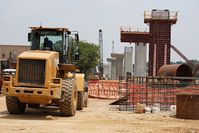Metro isn’t always the best option for transit expansion

Photo by VaDOT on Flickr.
When local leaders start thinking about adding new rapid transit to the region, usually the conversation centers around Metrorail. Metro has been so transformative for the Washington region that it’s hard to think in other terms. Unfortunately, that can lead to inefficient spending.
Consider the example of the Silver Line.
Phase One of the line, to Tysons Corner, is without a doubt one of the most promising infrastructure investments in America. Tysons Corner has more office space than downtown Baltimore and Richmond combined, but lacks the infrastructure necessary to support itself.
It’s a dysfunctional behemoth that really does need a top-quality Metro line in order to be transformed into a manageable, functional urban place. Accomplishing that transformation will be well worth the $2.76 billion price-tag.
Then there’s Phase Two.
Phase Two of the Silver Line will do no such thing. For $3.83 billion, more than a billion dollars more than Phase One, Phase Two will extend the line 11.5 miles into Loudoun County, with five stations that will be used primarily as park-and-rides plus a sixth at Dulles Airport.
For $333 million per mile we get a shuttle to the airport and some park-and-rides. There are some plans for Transit Oriented Development, but nothing like Bethesda or Ballston. Certainly not to the scale of Tysons Corner.
Park-and-rides and transit access to the airport are great things, but consider what other transit investments Northern Virginia might make with that same $4 billion.
Arlington’s proposed streetcar on Columbia Pike will cost an average of $27 million per mile. That suggests that for the same cost as Phase Two alone, Northern Virginia could build 140 miles of streetcar lines.
Granted, streetcars aren’t as good as Metro, but isn’t the opportunity to blanket every major corridor in Northern Virginia with rail transit at least worth considering? Imagine bonafide trains running up and down Route 7, Route 50, Little River Turnpike, Chain Bridge Road — a whole network that could take you anywhere. To me, that seems better than the tail end of a single Metro line.
Of course, providing transit to Dulles Airport is important, but we can do better for less money. The big problem with the Silver Line is that with all its stops between Dulles and downtown Washington, the trip is going to take a long time. If all you want to do is get to Dulles, then a new bus rapid transit line could get you there faster than Metrorail, and it could be built for less than the cost of a single mile of new Silver Line.
With streetcars and BRT we could have had a comprehensive network of high-quality transit covering all of Northern Virginia, for the same cost as this one Metro extension. Unfortunately, nobody thought to consider that alternative. Instead of using our money efficiently to serve the most people, we defaulted to thinking of Metrorail as a one-size-fits-all solution.
It’s probably too late to change anything about the Silver Line. The funding streams are already set up to channel money to that project, and opening it up for debate in these times of slim budgets and potentially hostile politicians would be extremely risky.
But years from now when local leaders start thinking about extending Metro farther into the suburbs of some other corridor, let’s take pause to remember the example of the Silver Line, and the transit network we could have had if we’d been open to other ideas.
The next time this happens, let’s not assume that Metro is the only answer. Let’s think outside the box and build something that will revolutionize the entire region.
